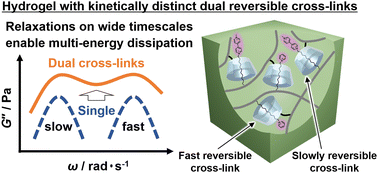Multi-energy dissipation mechanisms in supramolecular hydrogels with fast and slow relaxation modes†
Abstract
Reversible cross-links by non-covalent bonds have been widely used to produce supramolecular hydrogels that are both tough and functional. While various supramolecular hydrogels with several kinds of reversible cross-links have been designed for many years, a universal design that would allow control of mechanical and functional properties remains unavailable. The physical properties of reversible cross-links are usually quantified by thermodynamics, dynamics, and bond energies. Herein, we investigated the relationship between the molecular mobility and mechanical toughness of supramolecular hydrogels consisting of two kinetically distinct reversible cross-links via host–guest interactions. The molecular mobility was quantified as the second-order average relaxation time (〈τ〉w) of the reversible cross-links. We discovered that hydrogels combining fast (〈τ〉w = 1.8 or 18 s) and slowly (〈τ〉w = 6.6 × 103 or 9.5 × 103 s) reversible cross-links showed increased toughness compared to hydrogels with only one type of cross-link because relaxation processes in the former occurred with wide timescales.



 Please wait while we load your content...
Please wait while we load your content...